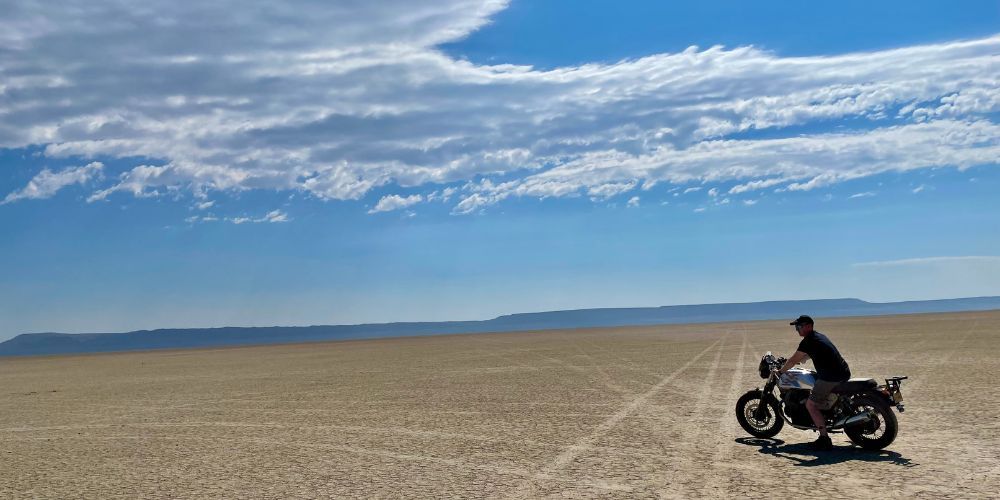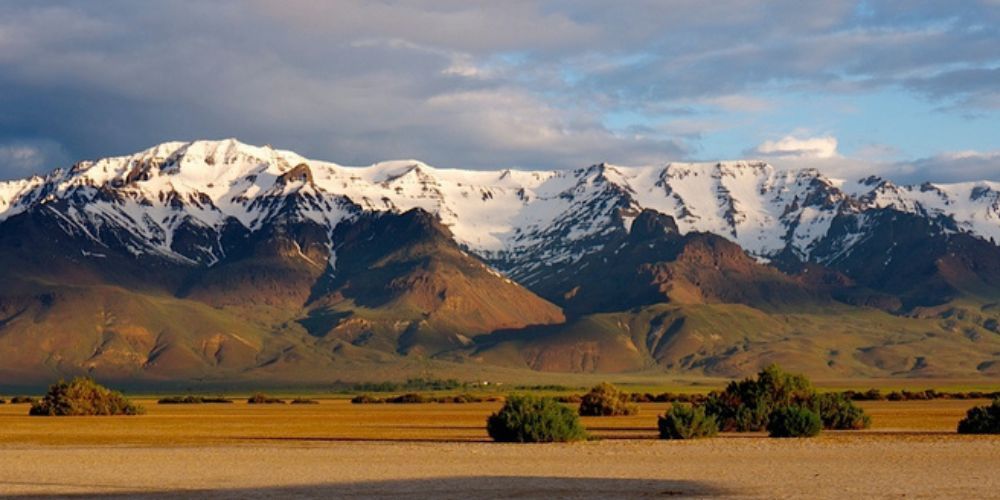Alvord Desert: A Photographer's Paradise in Oregon
June 22, 2024
Indeed, the Alvord Desert is a photographer's dream. This vast lake bed flanked by towering mountain ranges offers uniquely dramatic landscapes. Imagine capturing the sun's gentle descent behind Steens Mountain or the deep shadows it casts across the desert's surface. Visiting the desert feels like entering a hidden chapter of Oregon's beauty, just waiting to be photographed.
Now, let’s explore more about its location and geography.
The Alvord Desert in Oregon offers stunning views of the surrounding mountains, serene landscapes, and notable geothermal features such as the Alvord Hot Springs and Borax Lake thermal spring complex. Visitors can also enjoy activities like the Steens Loop Tour Route, which provides panoramic views of the desert.

Location and Geography of Alvord Desert
Picture this: a mesmerizing, expansive dry lake bed nestled in Southeastern Oregon, with towering mountain ranges looming as sentinels. The Alvord Desert spans approximately 12 miles by 7 miles, hugging the base of the striking Steens Mountain at an elevation of about 4,000 feet.
The desert's unique position places it within the high desert region, where the combination of low annual precipitation (less than 7 inches) and its immense size make it one of the most remarkable geological features in Oregon. The otherworldly beauty doesn't stop there—the Alvord Desert offers breathtaking views, quiet serenity, and a desolate landscape that stretches as far as the eye can see.
Surrounded by natural wonders on all sides, the Alvord Desert is flanked by not one but two dramatic mountain ranges: the magnificent Steens Mountain that towers 5,000 feet above and the Pueblo Mountains to the east. This geographic positioning ensures an awe-inspiring view from every vantage point; it's no wonder why photographers are drawn to capture its stunning landscapes.
Intrigued by the captivating allure of the Alvord Desert's geographical splendor? Let's now venture into a deeper exploration of its notable geographical features.
Notable Geographical Features
The Alvord Desert is no ordinary desert; it boasts unique geographical features that set it apart. One remarkable feature is the playa surface, a distinctive dry lake bed known for its flat, barren expanse. When rain falls, it transforms into a glistening mirror, creating a surreal and mesmerizing sight that provides stunning photo opportunities. Imagine capturing the reflective surface after a refreshing rainfall, with the surrounding mountains casting their shadows on this natural mirror.
This phenomenon offers an almost otherworldly backdrop for photographers seeking to capture a truly unique natural spectacle. The interplay of light and reflection on the playa surface creates an idyllic setting that presents infinite creative possibilities for photographers. The juxtaposition of the vast, open expanse against the surrounding mountains makes for compelling compositions that evoke a sense of awe and wonder.
Steens Mountain
Another distinct feature in the Alvord Desert's landscape is Steens Mountain. This 30-mile fault-block mountain overlooks the desert, offering a diverse range of photographic vistas. From snow-capped peaks in winter to wildflower-filled valleys in spring and summer, Steens Mountain presents an ever-changing canvas for photographers to explore.
The mountain's varying elevations provide different perspectives for capturing the desert landscape throughout the year. Wildlife, including wild horses and various bird species, can also be observed in this area, adding an element of biodiversity and dynamic visual interest to photographic compositions.
These notable geological elements collectively enrich Alvord Desert's visual tapestry, making it a paradise for photographers seeking to capture the beauty of nature in its most raw and unadulterated form.
This exceptional combination of features makes Alvord Desert one of Oregon's most visually captivating destinations for photography enthusiasts, offering boundless opportunities to capture the essence of untamed wilderness and natural splendor.
With these unique geographical features, Alvord Desert presents unparalleled opportunities for photographers to capture nature's wonders at their most dramatic and breathtaking moments.
Climate and Wildlife in the Alvord Desert
The Alvord Desert features a high desert climate with significant temperature fluctuations throughout the year. Winters bring cold, snowy weather, while summers are scorching hot and dry. This creates a diverse, ever-changing landscape that serves as a wellspring of inspiration for photographers. When temperatures drop and snow blankets the desert, the scene transforms into a winter wonderland, offering a rare opportunity to capture the ethereal beauty of a snow-covered desert.
In contrast, the summer months bring relentless heat that shrouds the desert in an otherworldly aura. The arid conditions result in clear skies and vibrant sunsets, providing photographers with an ideal backdrop for capturing dramatic landscapes illuminated by the golden hues of the setting sun. These stark seasonal variations not only influence the visual appeal of the Alvord Desert but also present an intriguing subject for photographers seeking to capture nature's dynamic and contrasting elements.
Climate Data
- Average annual precipitation: 7 inches
- Average temperature range: 20°F to 90°F
Moving beyond its climate, let's delve into the vibrant wildlife that inhabits this seemingly inhospitable environment.
Despite its harsh conditions, the Alvord Desert is teeming with life. The area serves as a critical habitat for a diverse range of wildlife, adding depth and interest to its photographic potential. Migratory birds grace the skies above, accentuating the expansive landscape with their graceful presence during different seasons.
Moreover, pronghorn antelope roam across the desert expanse, forging an intimate connection with the untamed wilderness and providing photographers an opportunity to capture these majestic creatures against the vast, rugged backdrop of the desert.
Additionally, mustangs roam freely across select regions of the desert, offering photographers unique subjects that embody freedom and grace within this stark and majestic environment.
Understanding the nuances of Alvord Desert's climate and wildlife uncovers a captivating tapestry of natural elements that beckon photographers to explore its ever-changing vistas and embrace its enduring spirit through their lens.
Photographic Opportunities in the Desert
For a photographer, capturing the rugged, ethereal beauty of an otherworldly landscape like the Alvord Desert is a dream come true. The vast open spaces and stark beauty provide an ideal canvas for capturing breathtaking images. Now, let's delve into some of the incredible photographic opportunities that await those willing to venture into this mesmerizing desert.
Wide Open Vistas
The Alvord Desert offers expansive vistas, unobstructed by light pollution or man-made structures. The wide-open spaces, especially during sunrise and sunset, create stunning panoramas that seem to stretch on forever. The play of light and shadow across the desert floor presents a surreal spectacle, with the snow-capped Steens Mountain providing a majestic backdrop. This makes it an ideal location for landscape photographers seeking to capture the raw, natural beauty of an unspoiled wilderness.
Photographers can experiment with various compositions, focal lengths, and exposure settings to encapsulate the sense of vastness and solitude that permeates this landscape. The interplay of natural light at different times of the day adds depth and dimension to the photographs, creating a captivating visual narrative of the desert's ever-changing moods.
Unique Playa Reflections
Following a rainfall, a magical transformation occurs in the Alvord Desert. The typically dry playa reflects the sky and surrounding mountains, creating a mirror-like effect that photographers find utterly captivating. This ephemeral phenomenon turns the desert floor into a gleaming canvas, offering photographers an opportunity to capture ethereal images that seamlessly blend the boundary between earth and sky. The mirrored reflections present an artistic challenge and reward creative experimentation as photographers seek to harness nature's fleeting spectacle into timeless imagery.
Capturing these reflective scenes demands careful composition and technical skill to optimize the interplay of light and water, resulting in surreal and evocative photographs that showcase both the stark beauty of the desert floor and the dramatic expanse of the sky above.
Night Sky Photography
In addition to its terrestrial marvels, the Alvord Desert also offers unparalleled opportunities for night sky photography. Thanks to its remote location and minimal light pollution, photographers have clear access to observe and capture celestial phenomena such as the Milky Way, meteor showers, and cosmic events. The expansive night sky becomes a mesmerizing tapestry of stars, planets, and celestial bodies, providing a striking contrast to the stark desert landscape below.
Photographers can utilize long exposure techniques and astrophotography equipment to capture the awe-inspiring grandeur of the night sky over the Alvord Desert. With proper planning and timing, they can immortalize celestial wonders that are often obscured by light pollution in more urbanized areas, creating profound visual narratives that transcend earthly boundaries.
As we've explored some of the photographic wonders awaiting visitors in Oregon's striking Alvord Desert, now it's time to turn our attention towards the myriad activities and historic attractions that enrich this remarkable locale.

Activities and Historic Attractions in the Desert
Venturing beyond the visual feast that the Alvord Desert offers, there are several activities and historic attractions that add depth and breadth to the experience.
Hot Springs
One of the most alluring experiences in Alvord Desert is soaking in the natural splendor of Alvord Hot Springs. Picture this: the vast expanse of desert unfolds before your eyes as you recline in warm, soothing geothermal pools. It's a fascinating encounter of opposites—the contrast of steaming water against the arid desert landscape makes it an enchanting photography subject. The mineral-rich waters and tranquil surroundings provide not only a serene retreat but also a captivating subject matter for photographers seeking to capture nature's dichotomy.
In addition to relaxation, the hot springs offer a chance to witness a unique geological formation at play. As the steam rises from these therapeutic springs, it creates an ethereal ambience against the stark beauty of the desert. This presents a wonderful opportunity for photographers to capture the interplay of elements—water, steam, and earth—creating stunning visual narratives that tell stories of relaxation and renewal amidst a harsh yet awe-inspiring environment.
Historic Attractions
The Borax Lake and the remnants of the Alvord Ranch stand testament to the rich human and natural history that blankets this unique landscape. These historic sites unveil compelling stories of survival, perseverance, and adaptation in the face of challenging conditions. Additionally, they present captivating subjects for photographers seeking to encapsulate not only the physical remnants but also the spirit of resilience embedded in these historic locations.
From capturing the weathered remains of structures against the backdrop of endless desert vistas to preserving poignant glimpses of human history etched into abandoned buildings, these historic attractions are a rich tapestry for photographers to explore. The inherent contrast between human endeavors and the unforgiving natural environment creates thought-provoking compositions that resonate with viewers on multiple levels.
Engaging with these activities and historic attractions not only provides immersive experiences but also widens your horizons as a photographer in framing striking images that encapsulate both natural beauty and human heritage.
Practical Tips for Photographers in Alvord Desert
When it comes to photographing the Alvord Desert, it's crucial to be well-prepared for the unique challenges and opportunities that this environment presents. From extreme temperature changes to vast open spaces, capturing the essence of this desert paradise requires more than just a camera. Let's explore some essential tips to ensure a successful and enjoyable photography experience.
Suitable Gear
Photographers venturing into the Alvord Desert should equip themselves with specific gear tailored to the demanding conditions. A wide-angle lens is essential for capturing the expansive landscapes, allowing you to bring the vastness of the desert into your frame. Additionally, a sturdy tripod is crucial for maintaining stability in windy conditions and capturing sharp, detailed images. For those interested in night photography, lenses suitable for astrophotography can enhance the ability to capture the stunning night sky above the desert.
The wide-angle lens offers photographers the opportunity to capture the panoramic expanse of the Alvord Desert, from its sun-dried cracked floor to the snow-capped Steens Mountain towering over 5,000 feet above. This lens enables them to encapsulate the grandeur of the desert's expansive beauty in their photographs, providing viewers with a true sense of its scale and majesty.
The tripod serves as an indispensable tool, especially when capturing long exposure shots during sunrise or sunset. It ensures that photographers can achieve maximum stability, minimizing any blurriness caused by camera shake. Furthermore, when shooting nightscapes or astrophotography, a sturdy tripod is essential for long exposure shots that capture the brilliance of the stars against the backdrop of the dark desert sky.
Protection
A photographer's well-being is just as important as their equipment. The Alvord Desert's arid climate and sun-drenched landscapes necessitate robust protection from its harsh elements. Essential items such as sunscreen, protective hats, and an ample supply of water are paramount in ensuring safety and comfort during extensive shooting sessions in this challenging environment.
The searing desert sun can be unforgiving, making sunscreen and hats crucial for shielding against harmful UV rays and preventing heat-induced discomfort or sunburn. Staying hydrated is equally vital, especially during physical exertion in hot temperatures. Adequate water intake helps photographers endure prolonged periods of shooting while mitigating the risks associated with dehydration.
As a photographer immersed in such a captivating and diverse setting, these practical considerations are fundamental in safeguarding your health and well-being while allowing you to fully engage with and capture the extraordinary beauty of Alvord Desert.
As you prepare to embark on your journey to discover the mesmerizing Alvord Desert, it's essential to take into account various factors related to accessibility and visitor considerations. These aspects will further enrich your experience and ensure a seamless exploration of this breathtaking landscape.
Accessibility and Considerations for Visitors
The Alvord Desert is indeed a captivating place, but it's important to note that accessibility can vary depending on the weather and road conditions. Visiting the desert usually involves using the Fields-Denio Road, but these gravel roads can become quite challenging after rain or snow. It's crucial to check the road conditions before heading out, as they can significantly impact travel ease and safety.
During inclement weather, Fields-Denio Road may become muddy and slippery, making it difficult to traverse. In winter, snow can make the road impassable without proper snow tires or 4-wheel drive. Keeping an eye on the weather forecast and road reports is vital to ensure a safe journey to and from the Alvord Desert.
Leave No Trace
As hordes of visitors flock to the beautiful Alvord Desert in hopes of capturing its stunning vistas, it becomes imperative to educate them about leaving no trace - a set of principles aimed at minimizing human impact on natural environments. The concept revolves around practicing responsible outdoor ethics, urging visitors to leave natural spaces just as they found them.
This includes minimizing campfire impacts, disposing of waste properly, respecting wildlife, and staying on designated trails. By adhering to these principles, photographers and nature enthusiasts contribute to the preservation of this awe-inspiring landscape for future generations. Ensuring that every visitor understands and respects these timeless principles is pivotal for protecting the Alvord Desert's delicate ecosystem.
Incorporating these considerations into your trip planning is not only a responsible practice but also crucial in maintaining the allure and integrity of this remarkable destination.
As you plan your visit to Alvord Desert, remember that your respect for its delicate ecosystem ensures its beauty for generations to come.
How do I get to the Alvord Desert?
The Alvord Desert is situated in southeastern Oregon, approximately 100 miles southeast of Burns. The primary route involves driving south from Burns on Highway 205 towards the small town of Fields. From Fields, you will take the Fields-Denio Road east and then follow signs to the desert. The roads leading to the Alvord Desert are primarily gravel and can be rough, so a high-clearance vehicle is recommended, especially if you plan to explore the more remote areas of the desert. Additionally, travelers should ensure their vehicles are in good condition and carry spare tires and emergency supplies, as services are sparse.
What is the best time to visit the Alvord Desert?
The optimal times to visit the Alvord Desert are in the spring (April to June) and fall (September to October). During these periods, the weather is more temperate, with daytime temperatures ranging from 60 to 80 degrees Fahrenheit, making it ideal for outdoor activities. Summer months can be extremely hot, with temperatures often exceeding 100 degrees Fahrenheit, which can be uncomfortable and even dangerous without adequate preparation. Winter visits are less common due to cold temperatures and the possibility of snow, particularly on the surrounding Steens Mountain. However, the desert can offer unique photographic opportunities in winter, such as snow-covered landscapes.
Are there accommodations or camping facilities available in the Alvord Desert?
Are there accommodations or camping facilities available in the Alvord Desert?
Accommodations near the Alvord Desert are limited but include options such as the rustic cabins and camping spots at Alvord Hot Springs. The hot springs provide basic amenities and a unique experience of soaking in geothermal waters with desert views. For those who prefer primitive camping, dispersed camping is allowed on Bureau of Land Management (BLM) land, which makes up much of the area. Primitive camping requires visitors to be self-sufficient, bringing all necessary supplies, including water, food, and camping gear. There are no designated campgrounds, so campers can choose their spots, but they should practice Leave No Trace principles to preserve the natural environment.
What activities can I do in the Alvord Desert?
The Alvord Desert offers a wide range of activities suitable for various interests. Photography enthusiasts will find the desert's unique landscape, including the expansive salt flats and surrounding mountain vistas, to be a paradise for capturing stunning images. Stargazing is another popular activity due to the minimal light pollution, providing clear views of the night sky and the Milky Way. Hiking opportunities abound, with trails leading to hot springs and around Steens Mountain. Off-road driving is a favored activity on the salt flats, where the flat, open space allows for exhilarating drives. Additionally, the desert is a great place for bird watching and observing wildlife, with species such as pronghorn antelope and various birds of prey commonly sighted.
Is it safe to visit the Alvord Desert?
While visiting the Alvord Desert is generally safe, it is important to take precautions due to its remote and rugged nature. Visitors should bring plenty of water, food, and emergency supplies, as there are no services nearby. It is also advisable to travel with a high-clearance vehicle and ensure it is in good working condition. Letting someone know your travel plans and expected return time can be crucial in case of emergencies. Checking the weather forecast is essential, as sudden weather changes, including thunderstorms and flash floods, can occur. The remote location means that help can be a long way off, so being well-prepared is key to ensuring a safe and enjoyable visit.
Check out the latest guides on camping gear
Check out the latest guides on motorcycling gear
Author: William Flaiz










